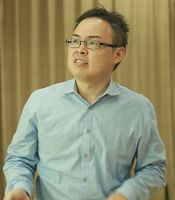| |
學歷 |
- JILA, 美國科羅拉多大學博士 (波德校區; 2010)
|
| |
現職與經歷 |
現職:國立清華大學物理系 副教授(2024/08-)
經歷:
- 國立清華大學物理系助理教授(2016/08-2024/07)
- 美國西北大學博士後研究員(2014/11-2016/08)
- 美國芝加哥大學博士後研究員(2010/12-2014/11)
|
| |
研究領域 |
- 玻色-愛因斯坦凝聚態
- 超低溫量子氣體
- 量子計算及模擬
- 離子阱物理
|
| |
研究方向 |
Updated November 11, 2017
近代量子多體系統牽涉廣泛,這些量子多體系統不單單只有物理研究上的價值,對 現實生活應用上也是非常重要的,例如高溫超導體及超流體。在大型量子電腦尚付之闕如的情況下,利用古典電腦來計算這些複雜的系統是不可行的。此時,物理學家們提出了一個新概念:Quantum simulation,即量子模擬。量子模擬的概念就是用一個容易控制的量子系統去模擬另外一個較難控制或是較難達到的量子系統。
超冷原子系統由於其卓越的可調性和超冷原子間簡單的交互作用為量子模擬中一個極 重要的平台。在我的研究小組裡,我們利用鋰原子 (Li) 和銫原子 (Cs) 所組成的量子混合氣體來進行量子模擬。這兩種原子由於質量非常的不同,因此可以用來模擬一些特殊的多體問題。其中的一個主題為準粒子 (quasiparticle) 在無序晶格缺陷中的多體侷域化現象 (many-body localization)。另外,鋰銫費什巴赫分子 (Feshbach molecule) 可以藉由雙光子躍遷合成基態鋰銫分子 (LiCs)。此分子具有極大的電偶極矩 (~5.5 Debye),非常適合用來模擬具長距作用力的量子系統,未來我們也將往此領域探索。
最後,由於量子模擬跟量子計算在實驗技術上的高度重疊性,量子模擬的研究可以視 為量子電腦早期研發的試金石。未來,希望我們所發展出的技術可以為台灣量子計算 的發展打下厚實基礎。
|
| |
代表著作 |
- Y.-D. Chen, W.-X. Li, M.-E. Chou, C.-H. Kuo, C.-S. Li, and S. Tung, Lithium-cesium slow beam from a two-dimensional magneto-optical trap, Phys. Rev. A 103, 023102 (2021).
- S. Tung, K. Jiménez-García, J. Johansen, C. Parker, and C. Chin, Geometric Scaling of Efimov States in a 6Li-133Cs Mixture, Phys. Rev. Lett 113, 240402 (2014).
- S. Tung, C. Parker, J. Johansen, C. Chin, Y. Wang, and P. Julienne, Ultracold Mixtures of 6Li and 133Cs Atoms with Tunable Interactions, Phys. Rev. A 87, 010702(R) (2013).
- S. Tung, G. Lamporesi, D. Lobser, L. Xia, and E. A. Cornell, Observation of the Presuperfluid Regime in a Two-Dimensional Bose Gas, Phys. Rev. Lett. 105, 230408 (2010).
- S. Tung, V. Schweikhard, and E. A. Cornell, Observation of Vortex Pinning in Bose-Einstein Condensates, Phys. Rev. Lett. 97, 240402 (2006).
|
| |
全部著作 (Peer reviewed publications) |
- S. Tung, K. Jiménez-García, J. Johansen, C. Parker, and C. Chin, Geometric Scaling of Efimov States in a 6Li-133Cs Mixture, Phys. Rev. Lett 113, 240402 (2014).
- L.-C Ha, C.-L. Hung, X. Zhang, U. Eismann, S. Tung, and C. Chin, Strongly Interacting Two-Dimensional Bose Gases, Phys. Rev. Lett 110, 145302 (2013).
- S. Tung, C. Parker, J. Johansen, C. Chin, Y. Wang, and P. Julienne, Ultracold Mixtures of 6Li and 133Cs Atoms with Tunable Interactions, Phys. Rev. A 87, 010702(R) (2013).
- X. Zhang, C.-L. Hung, S. Tung, and Cheng Chin, Observation of Quantum Criticality with Ultracold Atoms in Optical Lattices, Science 335, 1070 (2012).
- C.-L. Hung, X. Zhang, L.-C. Ha, S. Tung, N. Gemelke, and C. Chin, Extracting Density-Density Correlations from In Situ Images of Atomic Quantum Gases, New J. Phys. 13, 075019 (2011).
- X. Zhang, C.-L. Hung, S. Tung, N. Gemelke, and C. Chin, Exploring Quantum Criticality Based on Ultracold Atoms in Optical Lattices, New J. Phys. 13, 045011 (2011).
- S. Tung, G. Lamporesi, D. Lobser, L. Xia, and E. A. Cornell, Observation of the Presuperfluid Regime in a Two-Dimensional Bose Gas, Phys. Rev. Lett. 105, 230408 (2010).
- V. Schweikhard, S. Tung, and E. A. Cornell, Vortex Proliferation in the Berezinskii-Kosterlitz-Thouless Regime on a Two-Dimensional Lattice of Bose-Einstein Condensates, Phys. Rev. Lett. 99, 030401 (2007).
- S. Tung, V. Schweikhard, and E. A. Cornell, Observation of Vortex Pinning in Bose-Einstein Condensates, Phys. Rev. Lett. 97, 240402 (2006).
- I. Coddington, P. C. Haljan, P. Engels, V. Schweikhard, S. Tung, and E. A. Cornell, Experimental Studies of Equilibrium Vortex Properties in a Bose-Condensed Gas, Phys. Rev. A 70, 063607 (2004).
- V. Schweikhard, I. Coddington, P. Engels, S. Tung, and E.A. Cornell, Vortex-Lattice Dynamics in Rotating Spinor Bose-Einstein Condensates, Phys. Rev. Lett. 93, 210403 (2004).
- S. Tung, Y.C. Chen, C.W. Lin, L. Hsu, Ite Yu,Cooling Atoms Below 100 uK,Chinese journal of physics (2000).
|
|

